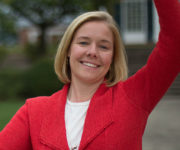Meet the Match
Bulgarian Gymnast Dreams of Accessibility for All Girls
Maria grew up in the golden age of communist gymnastics. During that time in the 80s, the Soviets reigned supreme and battled other Eastern European countries for a number of gymnastic titles. Maria’s father, a sports journalist, was excited for his daughter to be a part of this Olympic movement. He went to multiple gyms trying to enroll Maria into their gymnastic programs, but was turned away. Based on her parent’s height, coaches determined that the four-year-old Maria would grow too tall to be a gold medalist. And they were interested in champions, not ‘charity.’
Finally, after great persistence, Maria’s father found a gym willing to accept his daughter into the program. As a rising star, Maria sacrificed a great deal to make the National Rhythmic Gymnastics team. At 14, she was training more than 12 hours a day. She no longer went to school; instead, the teachers came to her. She practiced in dimly lit, crumbling buildings leftover from the communist system; there was no heating or air conditioning, just the mat, the team, and the coaches.
“The coaches during that time had very strong personalities. It was a communistic era and the coaches behaved that way. We couldn’t say anything to them about how we feel. They used us like a material to achieve their goals. It was more about their career than it was about us. There were days when I was physically and emotionally exhausted. But you have to continue to push yourself to the limit because you have no choice. Sometimes you even cross the line. I learned from this experience that the human being is the most important thing and that the human being has limits.”
After much success in the national ranks, Maria finished her career determined to change the way rhythmic gymnastics were practiced in Bulgaria. As a Senior Lecturer in the National Sports Academy, Maria is responsible for educating the next generation of coaches and sports managers in new methods of training and psychology. She also runs her own rhythmic gymnastics club, in which more than 100 young girls participate. Maria was also recently invited by the Bulgarian President to serve on the Scientific Advisory Committee to the National Gymnastics Federation. Because of her positions in the educational, governance, and private sector, Maria has the platform to influence tremendous change in Bulgaria.
Through this program, Maria wants to make gymnastics accessible for all girls in Bulgaria, regardless of physical stature, ability, or socioeconomic status. She believes the lessons learned in sport are important for female development and should not be limited to the elite performers. She sees this program as a chance to improve her managerial, training and entrepreneurial skills. We believe Sarah and her team at USGA are a great fit for Maria’s goals.
At the USGA, Sarah and her team specialize in several key areas: research, infrastructure, and training young professionals. Research is a key component to the USGA experience and one that has great crossover with Maria’s goals. Through research, the team at USGA explores barriers to the game (e.g. pace of play) and works to remove or reduce those barriers to create the infrastructure needed to grow the game. Maria will learn new strategies that she can apply to rhythmic gymnastics, reducing the barriers that prevent young girls from entering the sport. In addition, the USGA has an extensive Boatwright Internship Program that trains young professionals to become golf administrators. We believe this model could be implemented in Bulgaria to promote the number of females in sports administration, multiplying Maria’s efforts to introduce a new philosophy of sport. We are excited to see the way these scholars brainstorm solutions to improve the situation for women and girls in Bulgaria.

